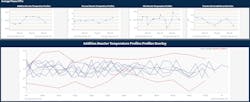Leveraging AI to accelerate digital outcomes in pharmaceutical processing
The cost and time required to bring new therapies to market is the leading cause of drug shortages globally, and without suitable supplies, patients sometimes face delayed access to necessary treatment.
Drug development processes are complex, sometimes requiring decades to transition from research and development (R&D) to clinical trials and into commercial manufacturing. Organizations face a wide array of challenges integrating and analyzing data throughout all stages of development. As therapies move into clinical trial phases, a lack of real-time insights can delay critical decision-making.
Along with market-specific pressures and regulatory hurdles, the pharmaceutical industry is pressed with general manufacturing challenges that impact every process industry, such as equipment downtime and unoptimized maintenance scheduling. To address these challenges head on, the sector must adapt and leverage evolving technologies, including artificial intelligence (AI).
Leveraging AI-inclusive advanced analytics platforms, organizations can usher in predictive maintenance, optimize product development operations and scheduling across assets, and accelerate product delivery timelines. By implementing these proactive practices, processors can also decrease maintenance and operational expenditures.
Data traceability concerns
Creating a new drug or therapy requires an extensive journey from initial R&D to commercial manufacturing. To minimize time to market and ensure necessary therapies reach patients more quickly, it is critical to identify inefficiencies and address process bottlenecks rapidly during each step of development.
As a drug transitions to each new phase of the product lifecycle, it often undergoes handoff to a new department, facility or even a contract manufacturing organization (CMO), which can make comprehensive analysis of its history challenging. However, data from every step must be seamlessly integrated to ensure product integrity as it advances through development. In addition, within each phase, processors must minimize unwanted variability in parameters that could lead to inconsistent product quality, as well as to understand variability inherent to the process. This must be standardized across every manufactured batch at all sites during the entirety of the drug product lifecycle.
In the highly regulated pharmaceutical industry, lengthy decision-making cycles render real-time insights challenging. Furthermore, delays often cause negative impacts on the manufacturing floor, which can degrade manufacturing quality and trial outcomes. From R&D through commercial manufacturing, compliance and regulatory requirement considerations must be built into the drug framework to ensure the highest quality.
AI-equipped advanced analytics platforms meet user needs
Addressing these and other challenges, advanced analytics platforms, such as Seeq, empower pharmaceutical organizations to reliably aggregate data across all stages of the drug product lifecycle. This type of centralized data repository enables comparison of drug processing across key stages of development, and it is essential for ensuring that critical process parameters are maintained when operations are transferred from a development facility to a CMO for production (Figure 1).
Once data is in a centralized location for comparison, it can sometimes be difficult to isolate process inefficiencies or optimize process parameters. Advanced analytics platforms do not require users to be analytics experts to extract key insights, enabling process subject matter experts (SMEs) to use the software just as efficiently as data scientists. Leveraging tools, such as a built-in AI assistant, users need only ask questions to gain insights from their processes. Similarly, no-code machine learning algorithms simplify analyzing historical data against real-time process parameters to predict and optimize operational outcomes.
During drug development, laboratory testing plays a key role in understanding drug efficacy and necessary process adjustments. Due to lab equipment delays, this information is not always available in time to make necessary adjustments. Using advanced analytics platforms, historic lab data can be collated alongside live process data to build predictive analytics graphs and forecast drug development processing outcomes. This empowers SMEs to make process adjustments in real-time, without waiting for lab results, which in turn enables early identification of potential operational issues to mitigate risks, and avoids costly delays, such as a lost batch.
With AI-enhanced platforms such as Seeq, continuous data monitoring in real-time can provide accelerated insights into key process metrics, providing an immediate and informed feedback loop to ensure consistent product quality. AI assistants can also provide guidance on building out automated reports for batch review. By minimizing the need for manual intervention, these tools streamline batch review and help maintain regulatory compliance.
Streamline data collection and analysis with AI
Propelled by cutting-edge, AI-driven insights, pharmaceutical organizations can accelerate the quest to develop and bring new drugs to market. Efficient process management with proactive adjustments help reduce R&D cycle times, and real-time monitoring and data-informed process improvements enhance product quality. Collectively, these factors reduce the risk of batch rejections and compliance issues.
Additionally, maintaining data in a centralized location through all stages of product development improves collaboration across departments and companies, facilitating streamlined decision-making (Figure 2).
As process efficiency increases and re-manufacturing failed batches becomes a problem of the past, organizations reduce operational costs, allowing expenditures previously dedicated to unnecessary trials and manufacturing adjustments to instead be directed toward capital improvement and optimization efforts. As a result, AI-driven predictions increase output potential, ushering additional drugs to market.
By leveraging integrated, automated reporting and AI-enhanced documentation practices, processors can assure compliance with regulatory requirements from R&D all the way to commercialization at large-scale. Improved documentation and validation procedures also streamline regulatory submissions in late-stage drug candidates.
These benefits empower technical teams with actionable insights about their processes, enabling informed decision-making at every step of development to optimize processes and identify deviations when they occur. This facilitates rapid mitigation, all while users need only refer to a single location for all information.
Achieving success in cutthroat trials and product development
Market fluctuations and an increasing demand for therapies require pharmaceutical processors to accelerate digital outcomes to meet the needs of this constantly-evolving sector. By integrating advanced analytics platforms and AI, organizations can achieve accelerated drug development timelines and quickly address process inefficiencies. This yields shorter development cycle times, promoting faster time-to-market for new therapies. Additionally, AI-driven insights coupled with continuous real-time monitoring support high-quality production standards, helping minimize batch rejections and compliance concerns.
With data from R&D, clinical trials, and commercial manufacturing managed within one system, SMEs are equipped with comprehensive analytics, enabling a seamless transition over the drug development lifecycle, and breaking down communication silos across departments and facilities. AI-enhanced documentation enables automated reporting, ensuring compliance with regulatory requirements consistently throughout the development lifecycle. Technical teams are empowered through actionable AI-driven insights to make data-informed decisions, increasing productivity and operational efficiency. In addition, predictive maintenance programs help processors identify and mitigate potential equipment and process issues before they create failures, reducing downtime and maintenance costs while prolonging equipment life expectancy.
Production and regulatory challenges are not new to the pharmaceutical industry, but when organizations empower their SMEs and production teams with AI-integrated advanced analytics platforms, they create efficiencies that enable team members to innovate more rapidly.
AI is further augmenting the past decade’s data-driven decision-making leap, providing pharmaceutical processors with the ability to deliver high-quality therapies at accelerated timelines. Organizations must integrate these methodologies with their advanced analytics platforms to remain competitive in today’s demanding manufacturing environments and ensure continued delivery of life-changing therapies to patients in a timely manner.




